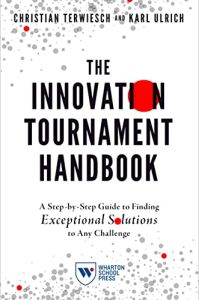Join getAbstract to access the summary!

Join getAbstract to access the summary!
Christian Terwiesch and Karl T. Ulrich
The Innovation Tournament Handbook
A Step-by-Step Guide to Finding Exceptional Solutions to Any Challenge
Wharton School Press, 2023
What's inside?
Learn how to build a culture of creativity and make innovation a regular practice within your workplace.
Recommendation
Some people think that great ideas happen out of the blue. Yet great innovation doesn’t have to be a random occurrence. Innovation experts Christian Terwiesch and Karl T. Ulrich have turned creative brainstorming into a step-by-step process that is well-structured, easily implemented and yields successful results. Terwiesch and Ulrich break down how to set up an innovation session, generate high-quality ideas and efficiently choose from the pool of opportunities. Through utilizing their guide, you can build a culture of creativity within your company ready to take on any challenge.
Summary
About the Authors
Authors Christian Terwiesch and Karl T. Ulrich are professors at the Wharton School of Business of the University of Pennsylvania.




















Comment on this summary